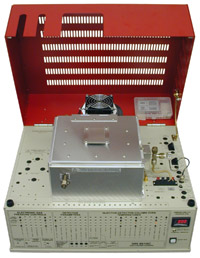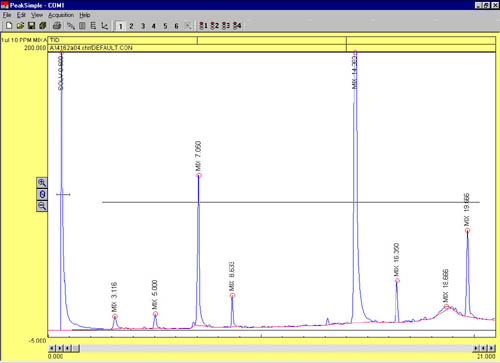
Can be run Gas-less in the Field!
- TID Detector
-
15-meter Capillary
Column
- Temperature Programmable Column Oven
- Temperature Programmable Column Oven
- Built-in, "whisper
quiet" Air Compressor
- 1 channel PeakSimple
Data System
- Heated Flash
Vaporization Injector
...on the compact 8610C chassis
The Explosives GC system from SRI combines a Heated Flash Vaporization injector, a built-in "whisper quiet" air compressor, and a Thermionic Ionization Detector for detection of nitroaromatic explosives such as TNT, and nitramine explosives such as RDX (C4) and HMX.
If only nitroaromatics are required, the GC will operate on the built-in air compressor alone, using its air for both carrier and make-up gas. This GC is especially convenient for field monitoring, and screening of explosives-contaminated soil and water, as might be found in military bases or practice ranges.
Unlike immunoassay or colorimetric detection methods which cannot discriminate the biodegraded transformation byproducts of TNT (2-amino-4, 6-dinotrotoluene, etc.), and which may not function well in the presence of high levels of interferences from other explosive compounds, the Explosives GC can separate and detect all the nitroaromatic compounds, even in the presence of interferences that would compromise other measurement techniques. For TNT and some other nitroaromatics, detection limits of 1ppb are routine. When nitroamines must also be detected, nitrogen is used for the carrier gas, and air is used for the TID makeup gas. Nitramine compounds like RDX exhibit lower response by a factor of 50.
| This chromatogram shows the separation of a 10ppm explosives mix using an Explosives GC. |  |
| Tested by the EPA's Environmental Technologies Verification (ETV) program for measuring explosives in soil! |
Also, download "On-Site Characterization of Explosive Residues in Soils and on Range Scrap Using GC-TID Analysis" by Alan Hewitt of the US Army Corps of Engineers here.
|
8610-1117
|
Explosives
GC System
|
£8,624.00
|
|||
|
(VOLTAGE:
for 110VAC, use
8610-1117-1; for 220 VAC, use 8610-1117-2)
|
|||||
|
Options
& Upgrades: additional detectors
with 4 channel serial or 6
channel USB PeakSimple data system, Split/Splitless
and PTV injectors
|
|||||